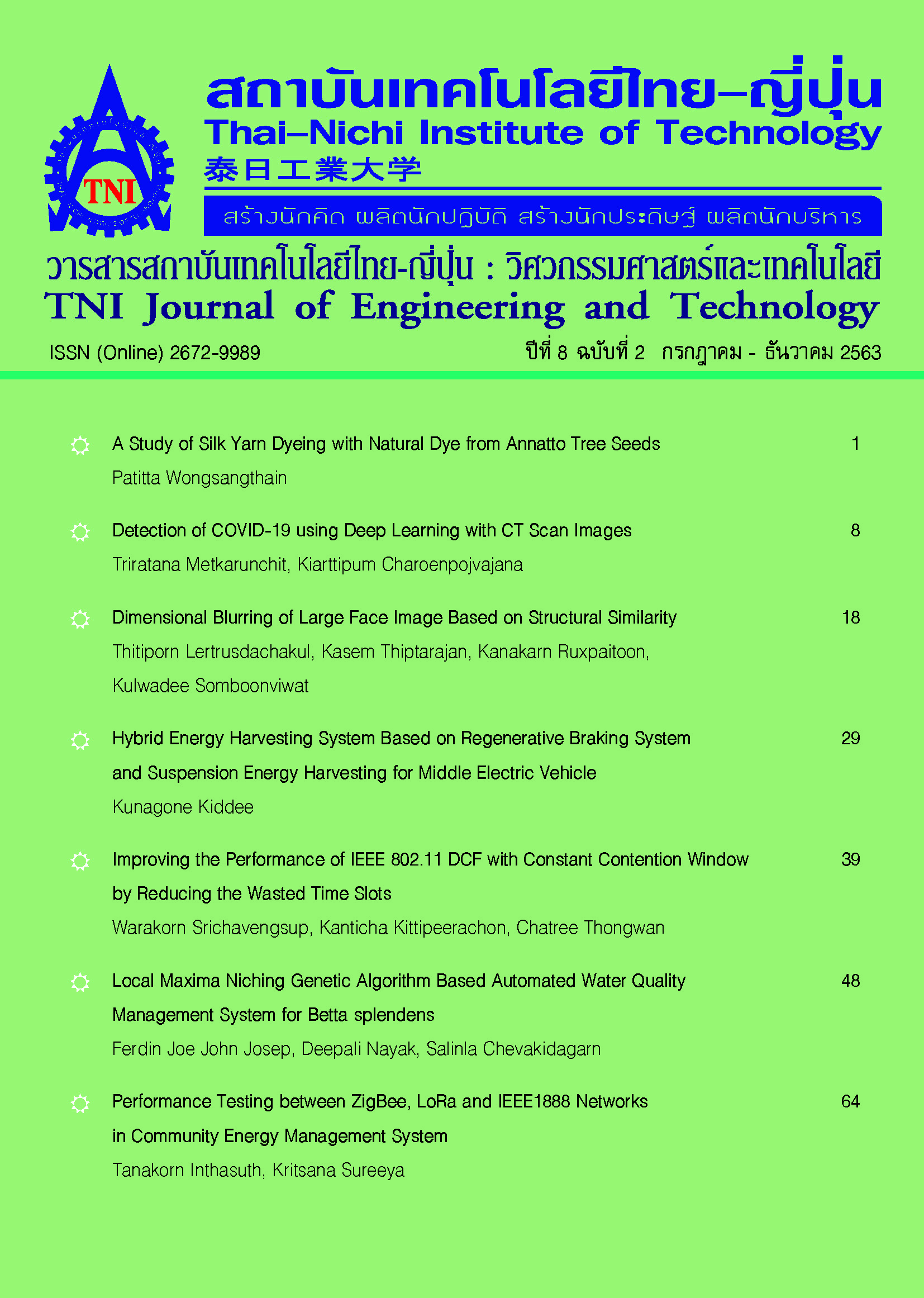Dimensional Blurring of Large Face Image Based on Structural Similarity
Main Article Content
Abstract
Face masking is widely used in print media, digital media and various online images for privacy and security protection. This research proposes an innovative face-blurring method focusing on large face blurring in large image size which usually requires a high degree of blur level to anonymize face. This great blur causes the face to be flat or very smooth and lack of visual dimension. Therefore, this research exploits the local structural similarity between large blurred and original images with Gaussian filter and contrast adjustment to adaptively create an opacity map for smoothly and appropriately blurring of face components. The details of main components are then very blurry and difficult to recognize personal identity while other parts of the face are less blurred. This adaptively face smoothing can improve a sense of dimensional perception and help to visually anonymize the portrait more natural resulting in the higher average value of structural similarity to the original image. The proposed method can be further applied to an aesthetically image censoring.
Article Details
Article Accepting Policy
The editorial board of Thai-Nichi Institute of Technology is pleased to receive articles from lecturers and experts in the fields of engineering and technology written in Thai or English. The academic work submitted for publication must not be published in any other publication before and must not be under consideration of other journal submissions. Therefore, those interested in participating in the dissemination of work and knowledge can submit their article to the editorial board for further submission to the screening committee to consider publishing in the journal. The articles that can be published include solely research articles. Interested persons can prepare their articles by reviewing recommendations for article authors.
Copyright infringement is solely the responsibility of the author(s) of the article. Articles that have been published must be screened and reviewed for quality from qualified experts approved by the editorial board.
The text that appears within each article published in this research journal is a personal opinion of each author, nothing related to Thai-Nichi Institute of Technology, and other faculty members in the institution in any way. Responsibilities and accuracy for the content of each article are owned by each author. If there is any mistake, each author will be responsible for his/her own article(s).
The editorial board reserves the right not to bring any content, views or comments of articles in the Journal of Thai-Nichi Institute of Technology to publish before receiving permission from the authorized author(s) in writing. The published work is the copyright of the Journal of Thai-Nichi Institute of Technology.
References
M. Gawron and U. Boryczka, “Heterogeneous fog generated with the effect of light scattering and blur,” JACS, vol. 26, no. 2, pp. 31-44, Oct. 2019.
G. Mather, “The use of image blur as a depth cue,” Perception, vol. 26, no. 9, pp. 1147-1158, Sep. 1997.
J. D. Pfautz, “Depth perception in computer graphics,” Computer Laboratory, University of Cambridge, Cambridge, United Kingdom, Tech. Rep. UCAM-CL-TR-546, Sep. 2002.
S. A. Cholewiak, G. D. Love, and M. S. Banks, “Creating correct blur and its effect on accommodation,” Journal of Vision, vol. 18, no. 9, pp. 1-29, Sep. 2018.
B. Ham, M. Cho, and J. Ponce, “Robust guided image filtering using nonconvex potentials,” IEEE Transactions on Pattern Analysis and Machine Intelligence, vol. 40, no. 1, pp. 291-207, Jan. 2018, doi: 10.1109/TPAMI.2017.2669034.
L. Bao, Y. Song, Q. Yang, H. Yuan, and G. Wang, “Tree filtering: Efficient structure-preserving smoothing with a minimum spanning tree,” IEEE Transactions on Image Processing, vol. 23, no. 2, pp. 555-569, Feb. 2014, doi: 10.1109/TIP.2013.2291328.
Q. Liu, B. Xiong, and M. Zhang, “Adaptive sparse norm and nonlocal total variation methods for image smoothing,” Mathematical Problems in Engineering, vol. 2014, Dec. 2014, Art. no. 426125, doi: 10.1155/2014/426125.
F. Zhu, Z. Liang, X. Jia, L. Zhang, and Y. Yu, “A benchmark for edge-preserving image smoothing,” IEEE Transactions on Image Processing, vol. 28, no. 7, pp. 3556-3570, Jul. 2019, doi: 10.1109/TIP.2019.2908778.
Z. A. Liu, Y. K. Hou, X. T. Zhen, J. Xu, L. Shao, and M. M. Cheng. (2020). Pixel-level non-local image smoothing with objective evaluation [Online]. Available: https://csjunxu.github.io/paper/PNLS.pdf
L. Xu, C. Lu, Y. Xu, and J. Jia, “Image smoothing via L0 gradient minimization,” ACM Transactions on Graphics, vol. 30, no. 6, Dec. 2011, Art. no. 174, doi: 10.1145/2024156.2024208.
X. Pang, S. Zhang, J. Gu, L. Li, B. Liu, and H. Wang, “Improved L0 gradient minimization with L1 fidelity for image smoothing,” Plos One, vol. 10, no. 9, Sep. 2015, doi: 10.1371/journal.pone.0138682.
S. Velusamy, R. Parihar, R. Kini, and A. Rege, “FabSoften: Face beautification via dynamic skin smoothing, guided feathering, and texture restoration,” in Proc. 2020 IEEE/CVF Conference on Computer Vision and Pattern Recognition Workshops (CVPRW), Seattle, WA, USA, 2020, pp. 2248-2256, doi: 10.1109/CVPRW50498.2020.00273.
Adobe. “Adobe Photoshop.” ADOBE.com. https://www.adobe.com/products/photoshop.html (accessed Sep. 26, 2020).
Rubber Duck Labs Inc. “Privacy image editor & anonymizer with face detection.” FACEPIXELIZER.com. https://www.facepixelizer.com (accessed Sep. 26, 2020).
Z. Wang, A. C. Bovik, H. R. Sheikh, and E. P. Simoncelli, “Image quality assessment: From error visibility to structural similarity,” IEEE Transactions on Image Processing, vol. 13, no. 4, pp. 600-612, Apr. 2004, doi: 10.1109/TIP.2003.819861.
K. Zuiderveld, “Contrast limited adaptive histogram equalization,” in Graphic Gems IV. San Diego, CA, USA: Academic Press Professional, 1994, pp. 474-485.
R. Lienhart, A. Kuranov, and V. Pisarevsky “Empirical analysis of detection cascades of boosted classifiers for rapid object detection,” in Proc. of the 25th DAGM Symposium on Pattern Recognition, Magdeburg, Germany, Sep. 2003, pp. 297-304.
P. Viola and M. Jones, “Robust real-time object detection,” International Journal of Computer Vision, vol. 57, pp. 137-154, May 2004.
USC-SIPI image database, University of Southern California, Nov. 2020. [Online]. Available: http://sipi.usc.edu/database
Labeled faces in the wild, University of Massachusetts, Amherst, Nov. 2020. [Online]. Available: http://vis-www.cs.umass.edu/lfw
Shutterstock, Inc.,“Stock images,” SHUTTERSTOCK.com. https://www.shutterstock.com/images (accessed Nov. 1, 2020).


